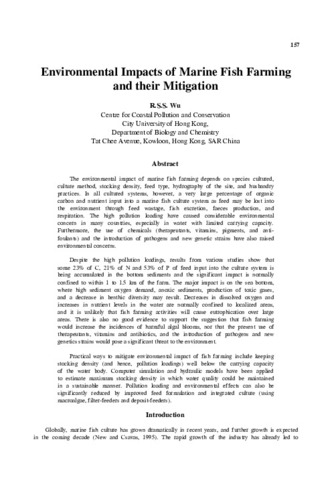Environmental impacts of marine fish farming and their mitigation
- Global styles
- MLA
- Vancouver
- Elsevier - Harvard
- APA
- Help
Share
นามธรรม
The environmental impact of marine fish farming depends on species cultured, culture method, stocking density, feed type, hydrography of the site, and husbandry practices. In all cultured systems, however, a very large percentage of organic carbon and nutrient input into a marine fish culture system as feed may be lost into the environment through feed wastage, fish excretion, faeces production, and respiration. The high pollution loading have caused considerable environmental concern in many countries, especially in water with limited carrying capacity. Furthermore, the use of chemicals (therapeutants, vitamins, pigments, and antifoulants) and the introduction of pathogens and new genetic strains have also raised environmental concerns.
Despite the high pollution loadings, results from various studies show that some 23% of C, 21% of N and 53% of P of feed input into the culture system is being accumulated in the bottom sediments and the significant impact is normally confined to within 1 to 1.5 km of the farm. The major impact is on the sea bottom, where high sediment oxygen demand, anoxic sediments, production of toxic gases, and a decrease in benthic diversity may result. Decreases in dissolved oxygen and increases in nutrient levels in the water are normally confined to localized areas, and it is unlikely that fish farming activities will cause eutrophication over large areas. There is also no good evidence to support the suggestion that fish farming would increase the incidences of harmful algal blooms, nor that the present use of therapeutants, vitamins and antibiotics, and the introduction of pathogens and new genetics strains would pose a significant threat to the environment.
Practical ways to mitigate environmental impact of fish farming include keeping stocking density (and hence, pollution loadings) well below the carrying capacity of the water body. Computer simulation and hydraulic models have been applied to estimate maximum stocking density in which water quality could be maintained in a sustainable manner. Pollution loading and environmental effects can also be significantly reduced by improved feed formulation and integrated culture (using macroalgae, filter-feeders and deposit-feeders).
การอ้างอิง
Wu, R. S. S. (2001). Environmental impacts of marine fish farming and their mitigation. In L. M. B. Garcia (Ed.), Responsible Aquaculture Development in Southeast Asia. Proceedings of the Seminar-Workshop on Aquaculture Development in Southeast Asia organized by the Aquaculture Department, Southeast Asian Fisheries Development Center, 12-14 October 1999, Iloilo City, Philippines (pp. 157-172). Tigbauan, Iloilo, Philippines: Aquaculture Department, Southeast Asian Fisheries Development Center.
Type
Conference paperISBN
9718511474คอลเลกชัน
- ADSEA '99 [21]



